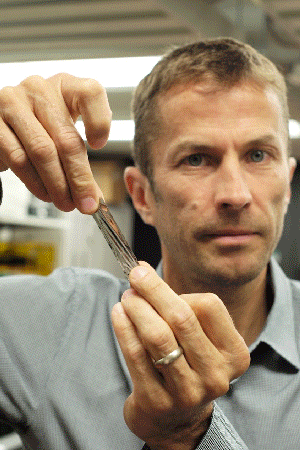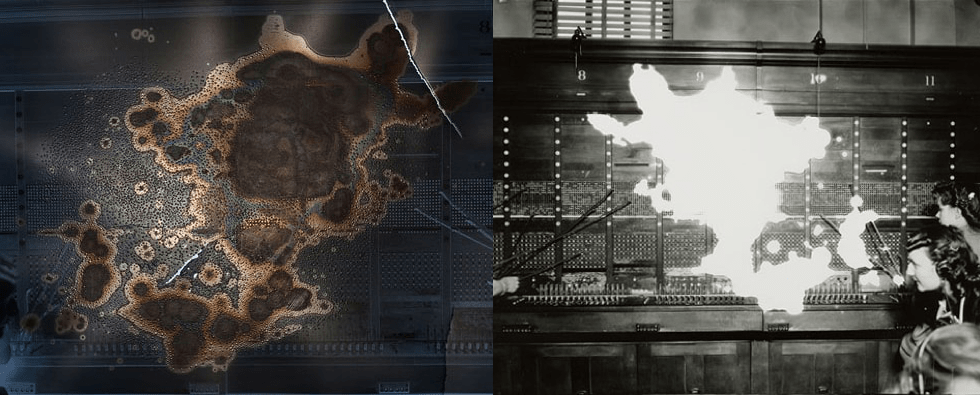
 top a makeshift workbench in the basement of a Lafayette, Colorado home, a dying tape drive whirs on its last breaths.
top a makeshift workbench in the basement of a Lafayette, Colorado home, a dying tape drive whirs on its last breaths.
John Koski sits down in his swivel chair and assesses the damage. First, he gives the tape drive a physical—measuring its performance to identify what’s wrong. After looking over the tests, he makes a diagnosis: worn-down bearings in the guiding system. Then, he begins his operation, disassembling defective parts and replacing them. The whole procedure takes anywhere from four to eight hours.

Koski brings failing machinery back to life. A collection of antique radios and clocks, portable audio cassette players, oscilloscopes, floppy disk readers, vacuum tube radios, and other ancient machinery lie around his workspace—the oldest piece of technology dating back to the 1920s. Many of them have been dubbed irrelevant. The revolving door of new technologies has phased out older generations from popular use. For Koski, now retired at age 71, repairing these devices, such as tape drives, is a crucial cog in the data-preservation clock.

The former magnetic tape technologist works as a digital storage contractor who runs a small operation out of his home consulting with companies, and as a hobby restores the hardware that reads electronic files of the past. Though his work may seem trifling on the surface, Koski is in a race against time—battling against the trepidations of aging technology and decaying data.
“If all the tape drives that are able to read and write a particular format of data fail, then the data on the disks [that] are recorded with that form become unreadable,” Koski says. That data becomes very difficult or expensive to try to recover. If you can’t find and pay for a device to read the data, he says, “you’ve lost it.”
 very second, history is deteriorating. Humans have worried over how to best preserve information for centuries. Around 3200 B.C., ancient Sumerians created cuneiform tablets, which are some of the earliest known data carriers from humanity’s past. Rolls and sheets of papyrus and vellum have also kept writings for centuries. Early 20th century punched cards perforated with data was a technology that persisted well into the 1970s and even the 1980s.
very second, history is deteriorating. Humans have worried over how to best preserve information for centuries. Around 3200 B.C., ancient Sumerians created cuneiform tablets, which are some of the earliest known data carriers from humanity’s past. Rolls and sheets of papyrus and vellum have also kept writings for centuries. Early 20th century punched cards perforated with data was a technology that persisted well into the 1970s and even the 1980s.
But in the 1950s, the strings of zeros and ones that make up data shifted from the purely physical to the digital.
In the early 1950s, magnetic tape made its debut as a data-archiving medium and changed the world of digital storage in computing. Early machines stored data on large, 10-and-a-half-inch diameter reels of tape. IBM, which was one of the first to develop the medium for data storage, started with a modest tape unit that could hold about 2.3 megabytes per reel on two tapes.
Koski witnessed the evolution of the storage medium firsthand, having been in the digital storage business since 1968 and working on magnetic tape for companies such as IBM, Hewlett Packard, and Quantum Corp.
“Over the years, the technology has progressed and the format of the tape has been compressed down to smaller and smaller sizes,” he says. Magnetic tape was reduced down to four-inch data cartridges and plastic cassette tapes the general public could use to consume video and audio.

Of course, most people haven’t watched or listened to an actual cassette tape in years. Audiocassettes and videotapes were replaced by optical CDs and DVDs, which have now been replaced by digital MP3s and live-streamed movies on Netflix or Hulu. Even if the average person does have a few tapes gathering dust, they have become more difficult to play because of the increasing scarcity of VHS players. On a larger scale, as of 2011, digital tape holds 11 percent of all stored data, falling behind hard disk drives and optical storage devices.
However, the decades-old storage medium continues to hold a presence in our lives, in more ways than you may think.
“Most people don’t realize that the technology is still used,” says Mark Lantz, advanced tape technologies manager at IBM’s research laboratory in Zurich, Switzerland. “You don’t realize that it’s really still extensively used in large data centers.”

Financial institutions, manufacturing companies, hospitals, movie studios, and more are all known to use magnetic tape storage in some capacity. Magnetic tape is what keeps your bank records safe, helps store data that predicts the weather, and backs up your email account if it crashes, Lantz explains.
For example, in 2011, tens of thousands of Gmail users logged into their accounts and found them completely empty. A glitch during a system software update accidentally deleted data. Even though Google, a large company with a lot of resources, replicates data across many different data centers around the world, the update was also being applied to those centers, affecting all the copies.
But, luckily, Google also backs up its users’ data on tape.

To Lantz’s understanding, “it took them a little while, but they actually were able to recover 100 percent of the data,” he says. “Most of the time you don’t realize that you’re relying on tape.”
The medium may be forgotten among the greater public, but it serves as a safety net. It’s often the bottom layer in the hierarchy of the modern-day data storage center.
Magnetic tape technology continues to pack on more data. Since IBM’s 1952 tape unit, the most recent generation of the most commonly used magnetic tape technology, called Linear-Tape Open, or LTO, can store up to 15 terabytes (or 15 thousand gigabytes) per cartridge. However, IBM has the ability to store 123 billion bits per square inch on tape, giving a single cartridge the capacity of a whopping 220 terabytes—that’s about 220 million books. And in August 2017, the company announced that engineers could squeeze 201 billion bits per square inch of tape, for a capacity of about 330 terabytes per cartridge. According to Lantz, IBM’s research has shown that the technology has the potential to continue doubling the capacity every two years for at least another 10 years.
“Most of the time you don’t realize that you’re relying on tape.”
The price point of tape is also much less expensive and tends to last longer than the current competing storage systems, such as hard disk drives and optical disk, explains Koski.
What’s more is the longevity of magnetic tape. Current generations of magnetic tape have an estimated shelf life of anywhere from 30 to 50 years, unlike hard disks, which are continuously spinning when used by the host computer, Koski says.
“That continuous spinning eventually brings up concerns with reliability, and five or 10 years of that kind of operation will eventually cause the disk to fail,” Koski says. Tape is “not being used continuously in that kind of mode. It’s typically in storage in an environmentally controlled condition.”
The medium is actually “quite stable, as long as you treat it nicely,” says Robert Roser, an experimental particle physicist at Fermilab in Illinois, which has seven automated magnetic tape libraries storing 70,000 tape slots’ worth of scientific data. “You can’t take it out and bring it in typical Chicago summer weather and expect it to be reliable.”
 ut, the material magnetic tape is made out of physically degrades, taking the message and content it carries with it.
ut, the material magnetic tape is made out of physically degrades, taking the message and content it carries with it.
The components of a storage material—or information carrier—affect how long the information survives, and how much time archivists have to preserve it.
“What is important is the material, the carrier,” says Jean-Louis Bigourdan, a senior research scientist at the Image Permanence Institute at Rochester Institute of Technology. “All materials decay at different rates.”

Files are subject to deteriorate by many means—for both digital and physical reasons. In the physical world, data becomes corrupted and unreadable from the aging or decaying material on which it’s been stored. Bigourdan, who has worked at the Image Permanence Institute for almost 25 years, studies the variables that cause storage mediums to decay and the factors that speed up the process. All kinds of media are sent to the lab, including black-and-white film, color slides, bound diaries, and magnetic tape. The team studies these objects to develop techniques and practical reports to help postpone degradation.
Pictures in photo albums fade from the glue and the plastic coverings that alter the dyes. Rolls of film have been obliterated for the silver they contain. Reels of tape become warped and sticky from warm temperatures, or lose their magnetic charge over time.
“There have been multiple examples where things completely disappear,” Bigourdan says.

Many of us are familiar with flipping through the withering pages of an old book: the once-creamy white paper of a favorite novel turning a shade of grayish-yellow. The change or fading of color is caused by a series of chemical reactions, or chemical decay. This “natural aging” affects all materials that contain organic matter, including dyes, plastic, and paper, explains Bigourdan.
Chemical decay also affects some inorganic materials, such as metals.
Embedded within many storage mediums are bits of metal. Over time, the metal oxidizes or corrodes, ruining the integrity of strips of photograph or film, Bigourdan explains. Already, Bigourdan estimates about 80 percent of U.S. films produced before 1929 during the era of silent cinema have been pillaged for their silver or degraded from the precious metal. Additionally, the nitrate-based film stock that was predominantly used until the 1950s was a highly unstable and flammable material, according to a 1993 film-preservation study by the Library of Congress. Numerous studio fires have turned footage into ash.

The rate of chemical decay depends on outside variables. Reactions are catalyzed by energy, or heat, moisture, and light. Exposure, particularly humidity, can also propagate mechanical decay, where a material expands or contracts leading to cracks or distortion.
At the New York Public Radio archives in downtown Manhattan, one of senior archivist Marcos Sueiro Bal’s favorite pieces to show off among the many early lacquer discs and reel-to-reel tapes, is a large, scientific oven. Unlike the appliance that heats up food, this special oven was built in the early 2000s to cook open-reel audiotapes from the 1970s and ’80s that have come down with a case of the “sticky-shed syndrome.”

Sticky-shed syndrome is likely caused by chemical degradation and can lead to potentially severe mechanical consequences, Sueiro Bal explains. The glue, or binder, used to apply the oxide that gets magnetized onto the plastic base of the tape becomes sticky from years of absorbing moisture from the air, chemically degrading. If you try to play a sticky tape, the dark, gummy residue can ruin the tape deck.
“It makes a god-awful noise. It’s kind of a high pitch squeal," says Sueiro Bal.
To temporarily restore the tape, archivists put them in the scientific oven for a few hours at controlled temperatures. And if baking in the oven does not suffice, archivists apply a tiny amount of lubrication along the tape, explains Sueiro Bal. The right remedy requires some experimentation, he adds.
Regardless of the type of medium, any collection is vulnerable to biological decay. Biological breakdown of material is caused by living organisms, such as mildew, insects, and, most notably, mold.
“Mold can grow anywhere if it’s too warm,” Bigourdan says.

The environment of the storage facilities is just as important as the medium on which the data is recorded, if not more important, according to Bigourdan. Not keeping the material at the correct temperature and humidity runs the risk of encouraging all three types of decay in a matter of decades or far less, Bigourdan says. And maintaining the perfect climate is even more essential for mediums expected to last for many decades, such as magnetic tape.
“It might last 30 to 50 years before it becomes degraded through chemical processes or temperature and humidity,” says Koski. However, incubating magnetic tapes in an ideal storage environment can only go so far.
 espite tape’s ability to last for decades, the time data spends on any one tape cartridge is often much less before it’s migrated—on the order of five to seven years, IBM’s Mark Lantz estimates.
espite tape’s ability to last for decades, the time data spends on any one tape cartridge is often much less before it’s migrated—on the order of five to seven years, IBM’s Mark Lantz estimates.
“The problem with 30 to 50 years is that any tape drive that wrote that data probably no longer can read and write data just because it has exceeded its expected lifetime,” Koski says. “It will eventually fail itself.”

Archives often undergo a migration haul when newer, denser generations of magnetic tape are released, reducing the actual amount of time data remains on a cartridge. Lantz and his research team at IBM recommend that clients migrate their data every couple generations.
The rapid turnover of tape technology causes more and more older generations of tape drives to die off and succumb to mechanical failure from extensive use. The data that may remain on the corresponding tape format then becomes lost—unreadable from technology obsolescence.
“Perhaps the most insidious and important cause of data decay is obsolescence of the media and format,” Koski says.
Different tape formats can only be read and written on with the appropriate tape drive. Retrieving the information is similar to trying to read a message written in a lost language: To read it back, you need a translator, but this is impossible if there is no one left who can decipher the words.
“The problem with 30 to 50 years is that any tape drive that wrote that data probably no longer can read and write data just because it has exceeded its expected lifetime.”
Most tape drives are able to read cartridges of LTO from two generations prior. But IBM announced that the eighth, most recent generation will only be compatible with the seventh generation—upping the stakes to access older data.
Archivists are “learning now that even if the tape will last 50 years, their tape drives won’t be around that long,” Koski says. This obsolescence “can occur unexpectedly, where data tapes that have been stored in archival vaults outlive the machines that can read or write them.”
Human experience spans centuries. We’re at risk of losing some of the most important documents, images, artifacts, and information if we don’t take the effort to preserve them, Koski says. Even in his retirement, he is helping smaller companies and firms gain access to their past data—a seemingly small but important duty to preserve our past. While his contracting work has shifted primarily to consulting, Koski continues to spend his free time collecting and repairing old machines at his workbench, tinkering with technologies before they become obsolete.
Written by Lauren J. Young
Design by Daniel Peterschmidt
Edited by Brandon Echter
Fact checking and copy editing by Michele Berger
Animated titles by Cat Frazier
Sidebar GIFs and in-text letters courtesy of The GifCities Project from The Internet Archive
Cover video via John Koski
Special thanks to Christian Skotte, Rachel Bouton, Danielle Dana, Johanna Mayer and the rest of the Science Friday staff, Alex Newman, and Terence Collins.
Published: December 15, 2017